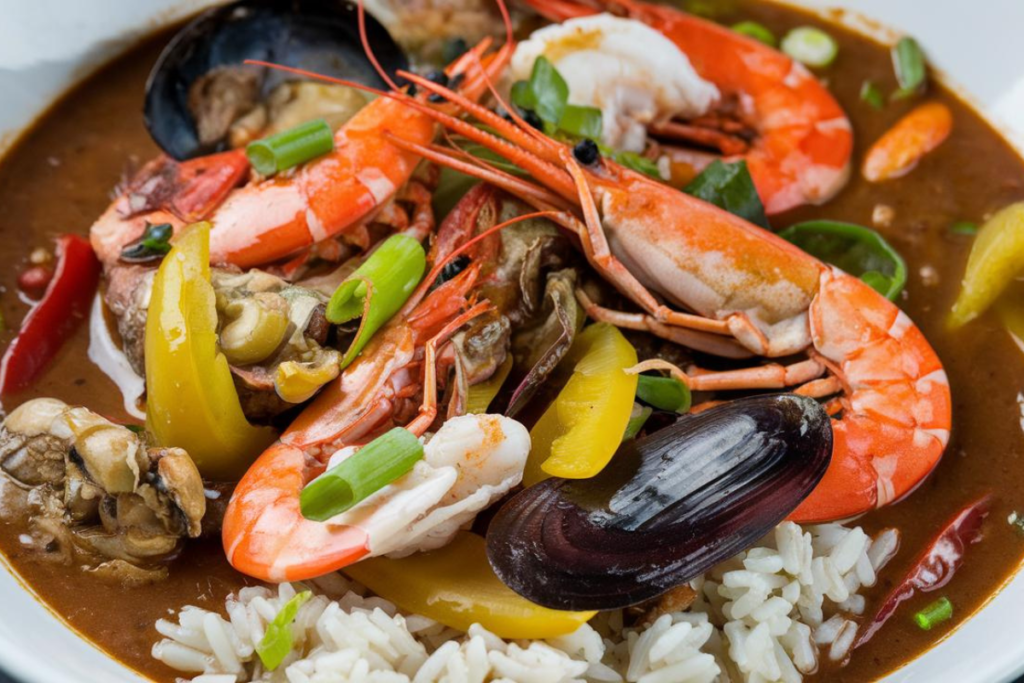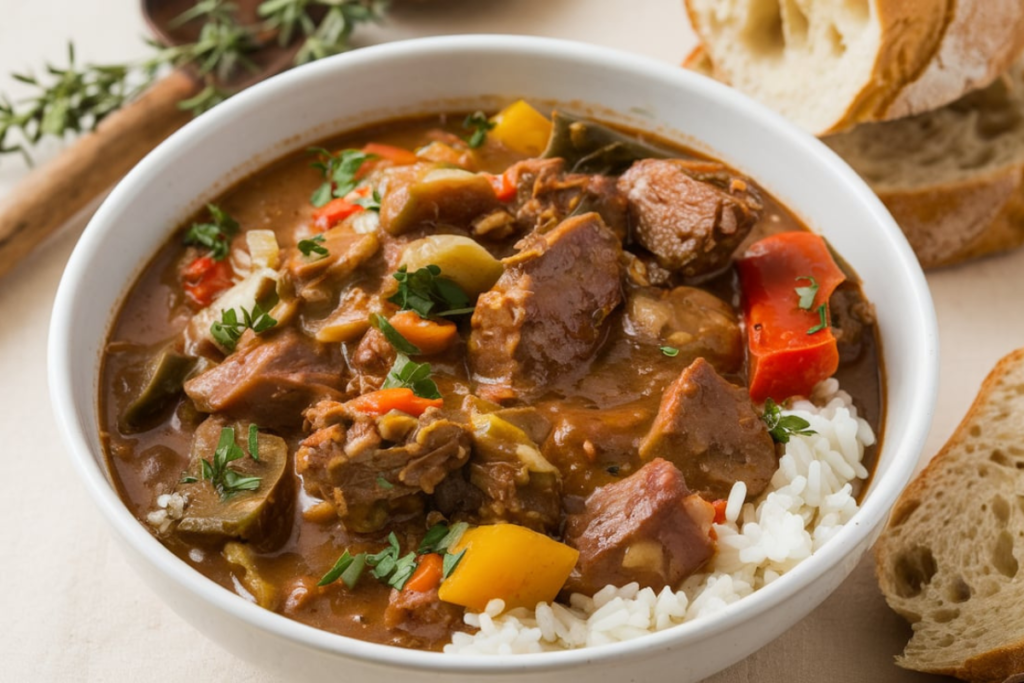The secret to good gumbo lies in mastering the perfect combination of ingredients, techniques, and a few age-old tricks passed down through generations. Gumbo is more than just a dish; it’s a culinary tradition steeped in the rich culture of Louisiana. This savory and comforting stew, known for its deep flavors and hearty ingredients, has become a staple in many households, especially in the South. But what exactly makes a gumbo good? Understanding the secret to good gumbo is essential to elevating this dish from just another meal to an unforgettable experience.
Introduction to Gumbo
Understanding the secret to good gumbo starts with knowing the dish’s origins and variations. Gumbo is a rich stew that combines ingredients from various cultures, including French, African, Spanish, and Native American cuisines. It typically features a mix of meat or seafood, vegetables, and a thickening agent, served over rice. The two primary types of gumbo are Cajun gumbo and Creole gumbo. While they share similarities, the secret to good gumbo often lies in these subtle differences. Cajun gumbo usually has a darker roux and omits tomatoes, while Creole gumbo includes tomatoes and has a lighter roux.
Why Understanding the Secret to Good Gumbo Matters
Creating gumbo is an art that involves careful attention to detail. The difference between a mediocre gumbo and an exceptional one often comes down to the techniques and ingredients used. By mastering the secret to good gumbo, you can create a dish that not only satisfies but also honors the rich history behind it.
The Roux: The Heart of Gumbo
What is a Roux?
A roux is a mixture of flour and fat cooked together, and it is the cornerstone of a good gumbo. It acts as a thickening agent and adds depth of flavor to the dish. The quality of your roux can make or break your gumbo, so understanding this aspect is crucial to unlocking the secret to good gumbo.
How to Make the Perfect Roux
- Ingredients: You’ll need equal parts flour and fat. Traditionally, oil is used, but you can also use butter or lard.
- Cooking Techniques: Cook your roux over medium-low heat, stirring constantly to prevent burning. The key is patience; a good roux can take up to 45 minutes to achieve the desired color and flavor.
- Achieving the Right Color: The color of the roux is critical. A blonde roux is light and used for dishes that require a more delicate flavor, while a dark chocolate roux is richer and more suitable for gumbo. For an authentic gumbo, aim for a roux that’s dark brown, almost like milk chocolate.
Common Mistakes to Avoid
- Burning the Roux: This is the most common mistake. If your roux burns, it will impart a bitter taste to your gumbo. If it happens, start over—there’s no way to salvage a burnt roux.
- Cooking Too Quickly: Rushing the roux will result in uneven cooking and an inconsistent texture. Take your time and allow the roux to develop slowly.
Choosing the Right Ingredients
Proteins
The choice of protein is crucial in determining the flavor profile of your gumbo. Common options include Andouille sausage, chicken, shrimp, and crab.
- Andouille Sausage: This spicy, smoked sausage is a staple in gumbo. It adds a deep, smoky flavor that enhances the overall taste of the dish.
- Chicken: Often used in combination with sausage, chicken is a popular choice for gumbo. Use bone-in chicken for added flavor.
- Seafood: Shrimp, crab, and sometimes oysters are used in seafood gumbo. Be sure to use fresh seafood for the best results.
Vegetables
Known as the Holy Trinity, onions, celery, and bell peppers form the base of most gumbo recipes. These vegetables are sautéed in the roux to build the foundation of flavor.
- Onions: Provide sweetness and balance to the dish.
- Celery: Adds a mild, fresh flavor that complements the richness of the roux.
- Bell Peppers: Bring a slight bitterness and a vibrant color to the gumbo.
Other vegetables like okra and tomatoes (in Creole gumbo) can also be added. Okra acts as a natural thickener, while tomatoes add acidity and sweetness.
Secret Ingredients
Every cook has their secret ingredient that they believe makes their gumbo stand out. Some of the commonly recommended ones include:
- File Powder: Made from dried and ground sassafras leaves, file powder adds a unique earthy flavor and thickens the gumbo.
- Rotel Tomatoes: Some cooks swear by adding a can of Rotel tomatoes to their gumbo for a bit of spice and tang.
- Worcestershire Sauce: Adds a deep umami flavor that enhances the overall taste of the dish.
There is some debate around the use of tomatoes in gumbo, especially in Cajun versions where they are traditionally omitted. Whether to include tomatoes or not is a matter of personal preference.
Explore more about traditional Cajun recipes to understand the variations in ingredients and methods.
Seasoning and Flavor Building
Essential Spices and Seasonings
Gumbo is all about layers of flavor, and the right seasonings are key to achieving this.
- Paprika: Adds a smoky sweetness.
- Thyme: Provides an herbal note that complements the meat and vegetables.
- Cayenne Pepper: For a bit of heat; adjust according to your preference.
- Bay Leaves: Infuse the gumbo with a subtle depth of flavor.
- Salt and Pepper: To taste, balancing all the other flavors.
Building Layers of Flavor
- Browning Meat: Before adding it to the gumbo, brown your sausage and chicken to enhance their flavor and add richness to the dish.
- Sautéing Vegetables: Cook the Holy Trinity in the roux until they are softened and have absorbed the flavors of the roux.
- Seasoning Throughout the Cooking Process: Don’t just add all your seasonings at once. Season as you go to ensure that each layer of the gumbo is flavorful.
Learn more about the history of gumbo and how different spices have been used traditionally.

Cooking Techniques for Perfect Gumbo
Cooking Methods
- Slow and Steady: The best gumbo is cooked slowly over low heat. This allows the flavors to meld together, creating a rich and cohesive dish.
- Timing and Patience: Gumbo often tastes better the next day, after the flavors have had more time to develop. If possible, make your gumbo a day ahead of when you plan to serve it.
Common Mistakes and How to Avoid Them
- Overcooking or Undercooking the Roux: As mentioned earlier, achieving the perfect roux is crucial. Make sure you cook it to the desired color without rushing the process.
- Improper Seasoning: Taste your gumbo as it cooks and adjust the seasonings as needed. It’s easier to add more seasoning later than to fix an overly salty dish.
- Not Letting Flavors Meld: Give your gumbo time to sit before serving. This resting period allows the flavors to blend and intensify.
Serving Gumbo: How to Do It Right
Accompaniments
Gumbo is traditionally served over rice, but there are other sides that can complement the dish.
- Rice: Use long-grain white rice for the best texture. Cook it separately and spoon the gumbo over it.
- French Bread: A crusty French loaf is perfect for sopping up the rich broth.
- Potato Salad: Some people enjoy a scoop of potato salad in their gumbo for a contrast in textures.
Presentation Tips
- Garnishing: Add a sprinkle of chopped green onions and fresh parsley before serving.
- Traditional Bowls: Serve gumbo in deep bowls to keep the broth hot and to contain the rice and meat.
FAQs: Common Questions About Making Gumbo
What is the Difference Between Cajun and Creole Gumbo?
Cajun gumbo is typically made with a dark roux and does not include tomatoes, whereas Creole gumbo has a lighter roux and often includes tomatoes. The choice of ingredients also varies, with Creole gumbo often featuring seafood and Cajun gumbo using more rustic, country-style ingredients.
Can I Make Gumbo Without a Roux?
While the roux is traditional, some people do make gumbo without it, using okra or file powder as thickening agents instead. However, the flavor and texture will differ from a traditional gumbo.
How Do I Store and Reheat Leftover Gumbo?
Store leftover gumbo in an airtight container in the refrigerator for up to three days. To reheat, gently warm it on the stove over low heat, stirring occasionally. Gumbo can also be frozen for up to three months.
What Are Some Vegetarian Alternatives for Gumbo?
For a vegetarian gumbo, substitute the meat and seafood with ingredients like mushrooms, tofu, or tempeh. Use vegetable broth instead of chicken or seafood stock, and rely on the roux and seasonings to build flavor.
Advanced Tips for the Gumbo Enthusiast
Experimenting with Different Proteins and Ingredients
Once you’ve mastered the basics, try experimenting with other proteins like duck, rabbit, or even alligator. Each will bring a unique flavor to your gumbo.
Modern Twists on Traditional Gumbo
For those with dietary restrictions, consider making a vegan or gluten-free gumbo. Substitute traditional ingredients with plant-based or gluten-free alternatives while keeping the rich flavors intact.
Regional Variations and Their Unique Ingredients
Different regions in Louisiana have their own versions of gumbo, each with unique ingredients. For example, some areas might use oysters, while others prefer adding crayfish. Exploring these variations can help you discover new and exciting ways to make gumbo.

Conclusion: Mastering the Art of Gumbo
Creating a good gumbo is about understanding the balance of flavors, the importance of the roux, and the careful selection of ingredients. By following the tips and secrets outlined in this guide, you can craft a gumbo that is not only delicious but also a true representation of this beloved dish’s rich heritage. So, gather your ingredients, take your time with the roux, and enjoy the process of creating a gumbo that will warm your soul and impress your guests.

